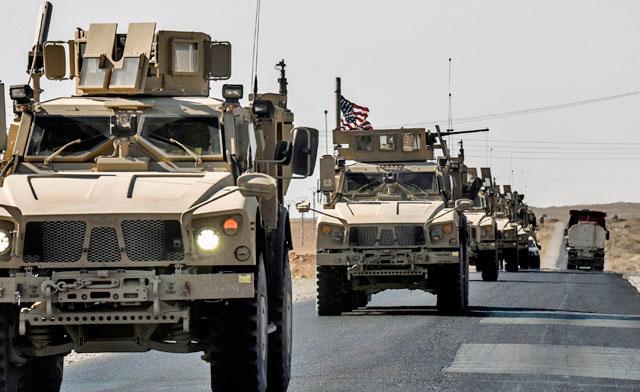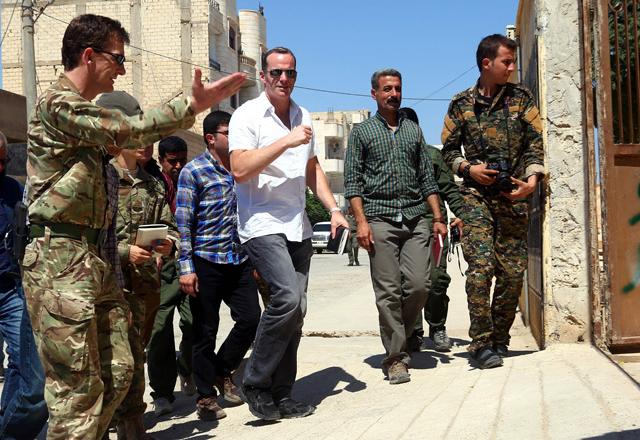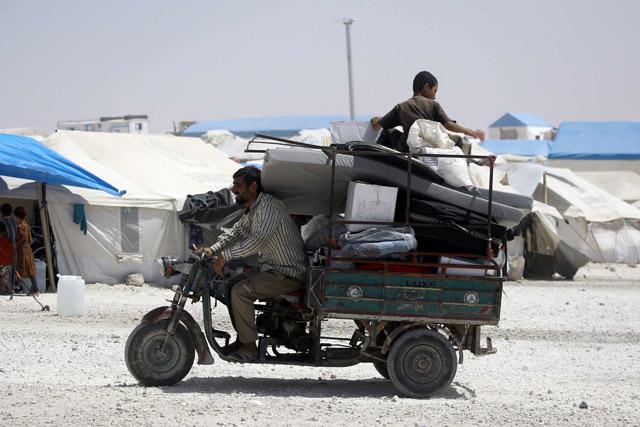You are here
Losing Syria bastion, Daesh lashes out behind front lines
By AFP - Sep 30,2017 - Last updated at Sep 30,2017

A US military convoy drives on a highway from Kobani to Ain Issa on Friday (AFP photo)
KOBANI, Syria — Just after sunrise outside Syria's Raqqa, dozens of the Daesh terror group extremists donned Kurdish military uniforms, piled into cars with weapons, and broke back into a district they lost control of months ago.
The raid was the latest evidence that Daesh, despite holding just a pocket of territory in its one-time stronghold, retains the capacity to wage deadly guerrilla attacks on areas thought to be relatively safe.
The extremists opened fire on a media centre run by the US-backed Syrian Democratic Forces (SDF) in Al Meshleb, the easternmost neighbourhood of Raqqa and the first area taken from Daesh in June.
"They were wearing YPG [Kurdish People's Protection Units] uniforms and came in six cars from the east," said the centre's head Kani Shahani, who was communicating with AFP during the attack.
The YPG forms the backbone of the SDF, a key force fighting Daesh in northern Syria with support from the US-led coalition against the extremists.
Hours of clashes left at least two SDF members dead and appeared to shake the confidence of the alliance of Arab and Kurdish fighters in the area as a safe rearbase.
The road into the east — which had seen regular civilian traffic over the past few weeks — has remained sealed for days, with large metal barrels and sand berms blocking access.
Tense SDF fighters were on high alert as they searched cars and motorcycles at checkpoints on Friday.
Two other failed infiltration attempts also hit the city's west this week.
On Friday, extremists were suspected of trying to sneak out of the city among civilians, SDF members said.
More than a dozen vans of SDF fighters could be seen speeding from a western suburb into the city to reinforce regular positions.
Sleeper cells, tunnels
"There has been more than one attempt from Daesh to break this siege on those inside, including striking behind the front lines," said SDF press chief Mustefa Bali, using the Arabic acronym for IS.
He said the attack on Al Meshleb was waged by at least 30 Daesh fighters who snuck in from territory a few kilometres east of the city limits.
"This shows that the infiltration was major. This area is supposed to be relatively secure," Bali said, adding that it was proof of "sleeper cells" in the area.
The SDF is tightening the noose on Daesh in a final pocket of territory that include Raqqa's national hospital and the football stadium.
While most of the city's neighbourhoods are under SDF control, the US-backed fighters said that they have not cleared them house by house.
Some feared Daesh was using a massive network of underground tunnels to move around in secret.
Jeker Derek, an SDF fighter in the city's west, said that his unit had fought off a surprise attack by Daesh earlier this week.
"Two days ago, we faced an attack from underground. A group of Daesh fighters came out from here and we clashed with them," the lean fighter said.
He was pointing to a now-sealed tunnel entrance in a building just hundreds of metres west of Raqqa's national hospital, where hundreds of extremists are thought to be holed up with civilians.
"This is the entrance, but it's not clear where it ends."
'Come from anywhere'
Other SDF members and representatives of the US-led coalition backing the offensive on Raqqa said Daesh was trying to blend in with displaced civilians to escape the city undetected before waging new attacks.
The coalition said last week it had detained several Daesh fighters — including a local leader — attempting to flee Raqqa alongside residents.
"Trying to sneak in with IDP [internally displaced people] flows, sneak out and lay low is something we're worried about," a senior commander from the US-led coalition backing the SDF's operations told AFP.
The commander said recent guerrilla attacks proved that Daesh was still a threat, but that it was lashing out in a last-ditch attempt to do damage to the SDF.
"It's that boxer on the ropes throwing punches — he's still going to get one in every once in a while. It's still dangerous," the commander said.
In Hawi Al Hawa, a western suburb of Raqqa under SDF control for months, fighter Jamal Mahmoud seemed nervous that his unit would be the next target.
He had heard about the hit-and-run attack on Al Meshleb earlier in the week and said it showed that "an attack could happen at any moment".
"On the frontline, you know your enemy is going to be facing you," he said.
"But in a liberated city that has all these tunnels, he could come at you from anywhere."
Related Articles
BEIRUT — US-backed fighters pierced extremist-held Raqqa from the south for the first time on Sunday, crossing the Euphrates River to enter
BEIRUT — US-backed Syrian fighters broke into the western part of the Daesh terror group's stronghold Raqqa on Saturday, they and a monitor
BEIRUT — US-backed forces have penetrated the heavily fortified heart of extremist bastion Raqqa for the first time, in a key milestone in t



















